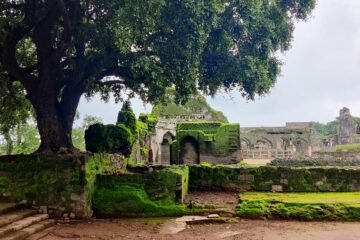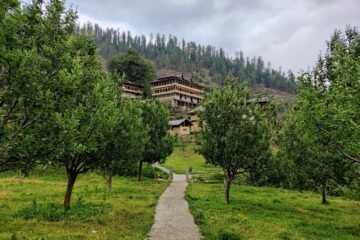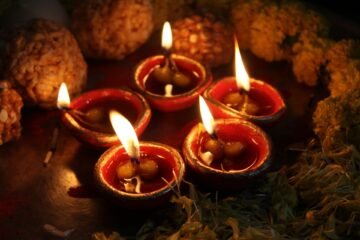Jinns and justice. When Feroz Shah Kotla was built by Firoz Shah Tughlaq in 1354 AD, the city was built to be a land of able administration and devout worship. But the winds of time transformed a well-established city into ruins, and a centre of orthodox Islamic worship into ethereal.
In our previous article on Feroz Shah Kotla, we explored the historical and architectural aspects of the fifth city of Delhi. In this article, we shall be exploring the aspect of worship related to these ancient ruins.
The Jami Masjid
After the palace ruins, we went to see the Jami Masjid mosque. The Jami Masjid is one of the largest and oldest surviving mosques and monuments which is still used for worship by devotees. It is a two-storied structure with cells at the lower level, and a courtyard for praying at the higher level. The courtyard’s entrance is from its North gate, and one has to climb a massive set of stairs to go to it. This gate, in yesteryears was embellished with ornamental stones and a parapet, but all of this has now been destroyed. However, the dilapidated entrance is still impressive in its sheer magnitude.
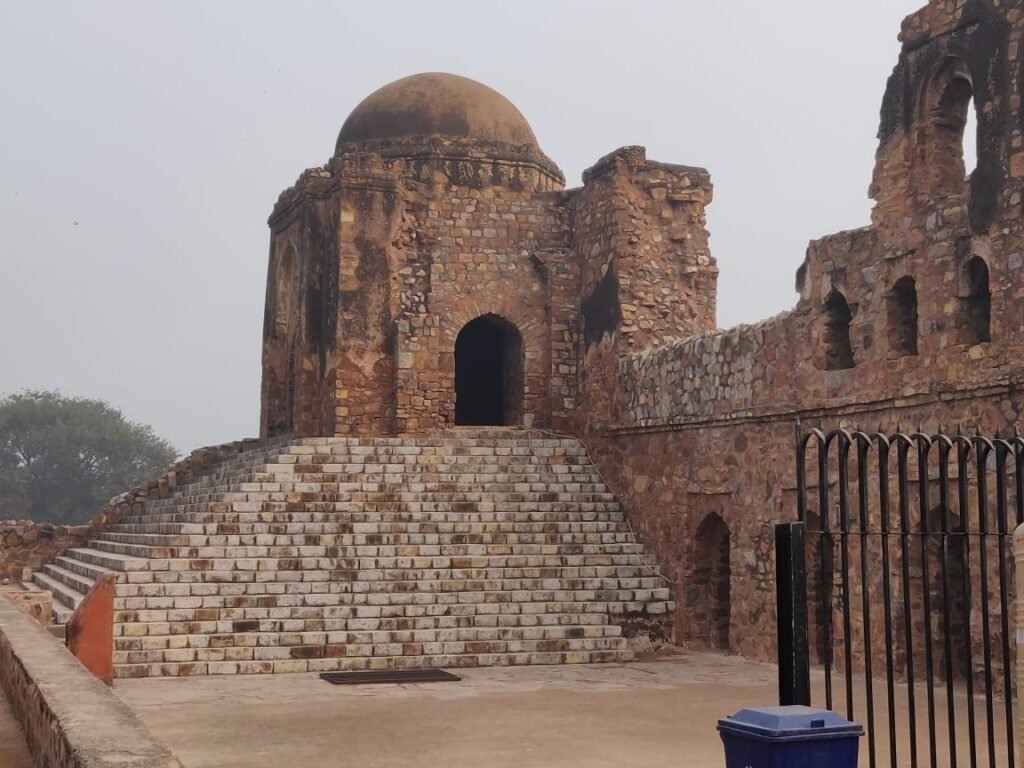
The mosque’s courtyard was a very large one with cloisters (pillared corridors), a prayer hall and a beautiful view. The courtyard now is mostly ruined, and except for a central floor design, one cannot even imagine that there was a large domed structure present in the middle of it. This central octagonal structure had inscriptions of the Futuhat-e-Firoz Shahi , i.e., the achievements of Firoz Shah Tughlaq inscribed on it.
The glorious structure of the Jami Masjid has witnessed quite a bit of history. It is said that the masjid was so spectacular in its age that Sultan Timur of the Timurid Dynasty came to see it. Timur is considered to be not only one of the greatest military leaders and tacticians in history, but also a great patron of art and architecture. And he was so impressed by the Jami Masjid that he constructed a similar mosque in Samarkand, Uzbekistan.
The Jami Masjid witnessed one more turning point of history when one of the later Mughal rulers, Alamgir II, was murdered here by his vizier Imad-ul-Mulk.
Today, not much remains of this glorious masjid. But fortunately, the Western wall with mihrabs is still intact. A mihrab is a semicircular niche in the wall that indicates the qibla, or the direction of the Kaaba in Mecca. This is the direction that Muslims should face while praying. To this day, devotees come to Jami Masjid everyday to pray and keep the essence of the masjid alive.

The City of Jinns
But every Thursday, the city of Tughlaq dynasty turns into something darker. Every Thursday, the ruins of Feroz Shah Kotla turns into the City of Jinns.
Jinn means the hidden or invisible one in Arabic. As per Islam, it is believed that Allah created angels from water, man from clay and jinns from smokeless fire. Being made out of a different substance, jinns are stronger and live longer than humans. They also shape-shift and travel long distances within a short time.
Like humans, jinns also have the free will to decide between good and bad, and at Feroz Shah Kotla they act as judges to dispense of judgement to those who seek justice.
These devotees treat the monument as a dargah, or the shrine of a saint. Usually dargahs are bright places containing the shrines of human saints. But in Feroz Shah Kotla’s unique case, the dargah is a dark ruin and the jinns are the saints.
On Thursdays, a big crowd of believers visit the palace with letters containing formal petitions related to their personal problems like a pending court case, bereavement, marital problems, etc. It is believed that the jinns collect these letters and decide upon the cases on Thursday night. Reminiscent of an official letter, each letter is followed by the name and address of the person. Interestingly, each devotee pins about nine to ten copies of their letters at different locations of the palace. This is because they believe that jinns work like a government body with a lot of departments. The letter of request has to reach the correct department in order for wishes and prayers to come true. There is a also a hierarchy among jinns, and the Ashoka Pillar (called laat, i.e. pillar wale baba) is considered to be the chief of jinns at Feroz Shah Kotla.
Almost as if to prepare the ruins for the coming of jiins, the dark cells of the ruins are decorated with candles, letters and flowers. Animals and birds in the vicinity, believed to be carriers to the jinns, are fed rice, milk and even meat.
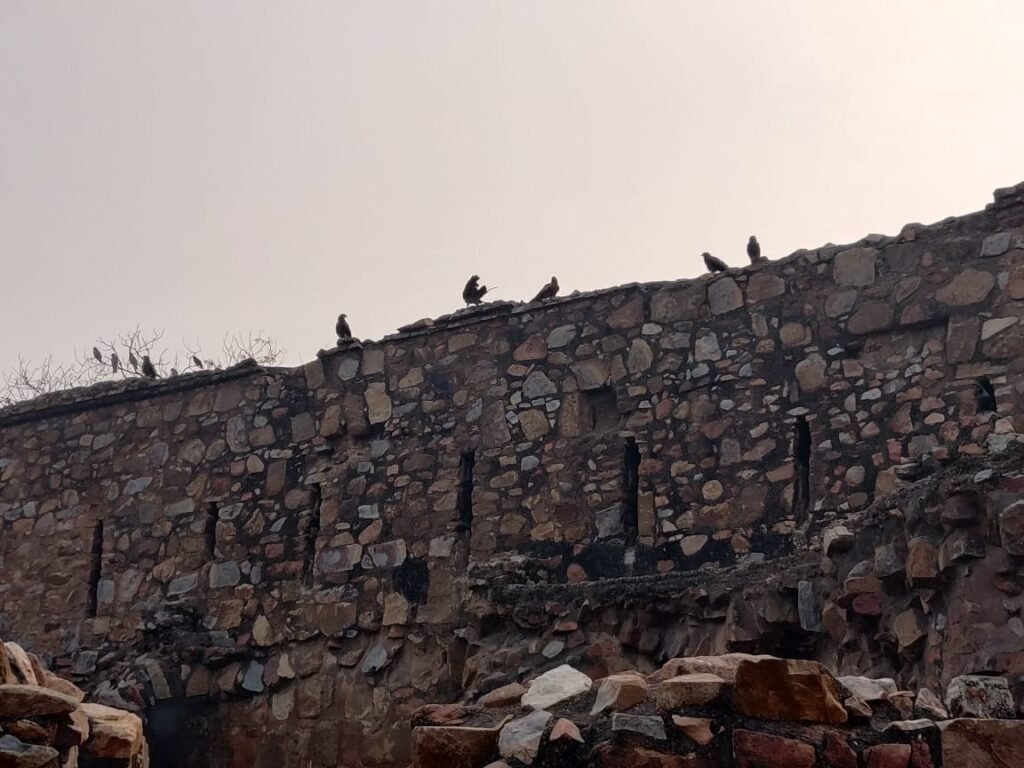
Interestingly, unlike the worshippers at Jami Masjid, the crowd believing in Jinns is much more syncretic. While a majority of them are Muslims, there is also a sizeable proportion of Hindus in the crowd.
This difference can probably be explained by how jinn-worship emerged in Feroz Shah Kotla.
Where It Began
‘Everyone gets justice here.’
Historians differ as to when the practice of jinn-worship first began at Feroz Shah Kotla. Some say that it is a continuation of the Tughlaq dynasty’s justice system where the common public would approach the royalty with petitions, and the petitions would be decided upon by the king.
In more recent history, the jinn-worship at Feroz Shah Kotla became more noticeable in 1977, soon after the controversial Emergency period of India. Around this time, a fakir (a religious ascetic) called Laddoo Shah came to live in the ruins. Soon, his followers also started visiting Feroz Shah Kotla often. It was Fakir Laddoo Shah who declared that he sensed the presence of higher powers in the area. He was even said to be blessed by the jinns with healing powers.
He who is at the verge of losing everything, looks even for the smallest sense of support. The Emergency period in India was particularly difficult for the Muslim population. It was especially the people of the nearby Shahjanabad, or Old Delhi, who faced a lot of hardships. During these uncertain times, they found solace in believing in and finding justice in any way possible.
And in those times of need, Laddoo Shah’s popularity, as well as his declaration of higher powers at Feroz Shah Kotla spread like wildfire.
Even to this day, the majority of the people who come to Feroz Shah Kotla on Thursdays come from Old Delhi and its adjoining areas, or from families belonging to these areas. And as we said before, the crowd is a secular one, with many Hindus also visiting the ruins.
Sometimes adversity is a great equalizing force.
***
This is the story of Feroz Shah Kotla- the fifth historical city of Delhi brought to life by Feroz Shah Tughlaq, and kept alive 700 years later by Jinns and those who seek justice.
References
- Jinnealogy, Everyday life and Islamic theology in post-Partition Delhi, Anand Vivek Taneja, HAU: Journal of Ethnographic Theory 3 (3): 139–65
- Believe it or not: Inside 14th century Delhi fort, djinns grant wishes, Hindustan Times
- A Castle Receives a Weekly Delivery of Delhi’s Secret Desires, The New York Times
